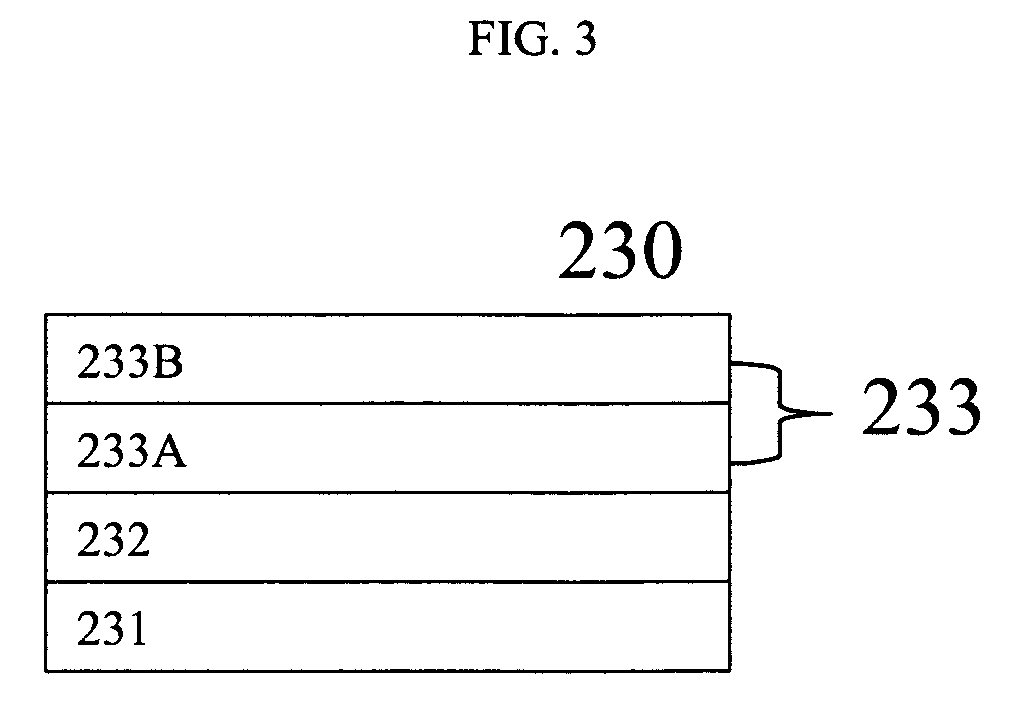OLEDs with improved operational lifetime
a technology of operating lifetime and oled, which is applied in the direction of discharge tube luminescnet screen, transportation and packaging, natural mineral layered products, etc., can solve the problems of insufficient lifetime and persisting low operational lifetime, and achieve the effect of improving the efficiency of oleds without adversely reducing the purity of color of emitted ligh
- Summary
- Abstract
- Description
- Claims
- Application Information
AI Technical Summary
Benefits of technology
Problems solved by technology
Method used
Image
Examples
example 1 (
DEVICE EXAMPLE 1 (INVENTIVE)
[0337] An OLED device (Device 1) was prepared as follows. A glass substrate was coated with about an 850 Å transparent indium-tin-oxide (ITO) conductive layer and was cleaned and dried using a commercial glass scrubber tool. The ITO surface was subsequently treated with an oxidative plasma to condition the surface as an anode. Over the ITO was deposited a 10 Å thick hole-injecting layer of fluorocarbon (CFx) by plasma-assisted deposition of CHF3. The following layers were deposited in the following sequence by thermal evaporation from heated crucible boats in a conventional vacuum deposition chamber under a vacuum of approximately 10−6 Torr: (1) a hole-transporting layer, 750 Å thick, including NPB; (2) a light-emitting layer, 600 Å thick, including the first host Dibenzo[b,k]perylene (DBP) (32.5 volume %) and the second host component, Alq3 (66.5 volume %) and containing 1.0 volume % light-emitting dopant DCJTB; (3) an electron-transporting layer (ETL), ...
example 2 (comparative)
DEVICE EXAMPLE 2 (COMPARATIVE)
[0338] An OLED comparative device (Device 2) was prepared in the same manner as Device 1, except the ETL did not contain Li.
example 3 (comparative)
DEVICE EXAMPLE 3 (COMPARATIVE)
[0339] An OLED comparative device (Device 3) was prepared in the same manner as Device 1, except the light-emitting layer included only one host component, Alq3 (99%), and contained 1.0 volume % light-emitting dopant DCJTB.
PUM
| Property | Measurement | Unit |
|---|---|---|
| optical density | aaaaa | aaaaa |
| thickness | aaaaa | aaaaa |
| thickness | aaaaa | aaaaa |
Abstract
Description
Claims
Application Information
 Login to View More
Login to View More - R&D
- Intellectual Property
- Life Sciences
- Materials
- Tech Scout
- Unparalleled Data Quality
- Higher Quality Content
- 60% Fewer Hallucinations
Browse by: Latest US Patents, China's latest patents, Technical Efficacy Thesaurus, Application Domain, Technology Topic, Popular Technical Reports.
© 2025 PatSnap. All rights reserved.Legal|Privacy policy|Modern Slavery Act Transparency Statement|Sitemap|About US| Contact US: help@patsnap.com



